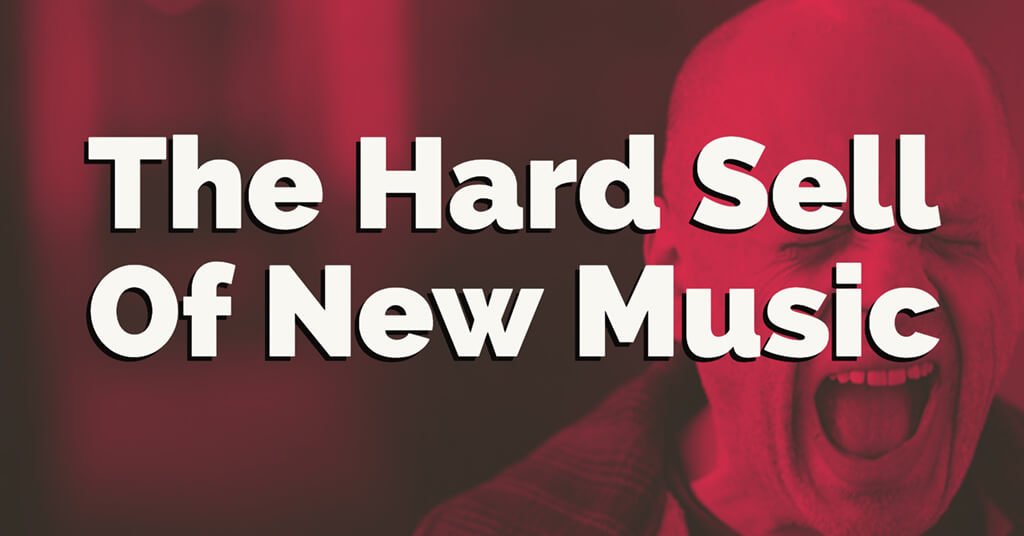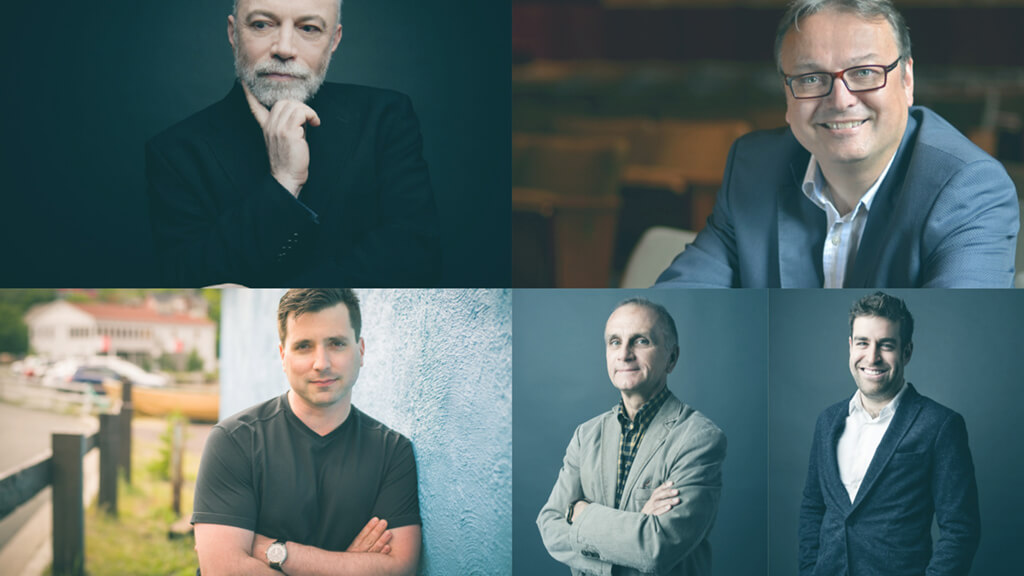
Earlier this year, the TSO announced the cancellation of its long-running New Creations Festival, a yearly showcase of contemporary classical music. It comes at a time when the TSO and orchestras all over the continent are increasingly programming performances like movie screenings with live music and crossover artists that turn beloved classics into pop music. Is the future of classical music in trouble? Does it mean that Toronto audiences don’t support new compositions?
Most contemporary composers would disagree with a gloomy diagnosis. “It’s a great time to be an artist, no question,” says Canadian composer Andrew Staniland.
Jordan Pal is the RBC Affiliate Composer with the TSO “There’s always doomsayers,” he notes. “This art is not going anywhere. You look back at the history of this art — people have been saying this forever. It’s always managed to thrive.”
Part of the reason for the conflicting impressions may be that new music itself is hard to define. Contemporary composers have at their disposal a palate of sounds that is unprecedented in scope. Canadian composer, pianist, conductor, and educator Gary Kulesha is also Composer Advisor to the TSO. “In the 21st century, there is emerging a kind of language which is…everything,” he says. “I’m aware of all the techniques available.” Using that broad range of options, he chooses sounds for their connotative and evocative power.
As in many other genres, a single category for classical music no longer seems anywhere near adequate. Greek-Canadian composer Christos Hatzis would go even farther. “I don’t believe in categorization of any kind.” It’s gone well beyond the simplistic way record stores used to put jazz and classical in different slots. “Both the listeners and the markets have moved beyond that,” he says. As he points out, it’s the industry and its larger institutions that have to catch up.
“I think one of the biggest problems around new music is the way people talk about it,” says Andrew Staniland. That, and a preoccupation with dissonant noise music. “It’s an unfortunate effect.”
Classical or art music has undergone a sea change over the last two decades or so. Music historians debate over when the Common Practice Period — characterized by tonality — began or ended exactly, but most generally put its demise roughly coinciding with the start of the 20th century. When many laypeople think of modern art music, they think immediately of the dissonant Modern period. That’s when composers deliberately eschewed any conventional notions of melody or harmony.
Innovation on its own can be a difficult listen, and dissonance doesn’t connect as easily with its audience. But, as Gary Kulesha points out, the 20th century was also a time when composers were developing the innovative range of sounds and techniques now available.
“It’s only been in the last 20 years that we’ve moved away from that,” Gary notes. Since about the turn of the 21st century, a new mode seems to be emerging. Is it another sort of Common Practice? “I think we are returning expression to music,” Gary says. With its anything-goes aesthetic, however, it becomes harder and harder to define what any commonality may be. “I don’t think we’re talking about style anymore.”
“There is something at work that is pulling us back towards accessibility.” — Jordan Pal
“It’s an incredibly pluralistic time,” says Jordan Pal. Still, he feels a common movement away from experimentation for its own sake. “There is something at work that is pulling us back towards accessibility.”
With a lack of consensus over style, presenting new music poses unique issues. Although the New Creations Festival will be no more, the TSO’s regular season programming does include individual concerts of new music, including a revival of John Adams’ City Noir, which premiered at New Creations in 2011. Still, it forms a small percentage of programming for the TSO or any modern orchestra.
“But I don’t think that’s unreasonable,” says Gary. “There would have to be a bias towards the music of the past just because of the sheer volume.”
Even with its inherent challenges, it seems that Toronto does appreciate new music, backing up the contention that audiences get it more than the institutions themselves at times. Despite the New Creations Festival’s demise, its last iteration in March 2018 saw good ticket sales, including a near sell-out for the finale on March 10, and standing ovations.
Mervon Mehta, Executive Director, Performing Arts for the Royal Conservatory is a proponent of contemporary classical music, and had it in his sights from the moment Koerner Hall opened its doors a decade ago. “Right from the outset, we knew we wanted (…) newly minted music.” In fact, the RCM commissioned a new piece by revered Canadian composer R. Murray Schafer for the grand opening.
In May 2018, Koerner Hall will be presenting the fifth version of the 21C Festival that showcases compositions of this century. “It’s doing well,” he reports. “We sell out some concerts.” The key, it would seem, lies in having realistic expectations. “We’re not talking pop music,” he says, pointing out the esoteric nature of the music. Some performances only sell at 50% or so. “And we’re quite happy with 50 percent.” In those five years of 21C, the RCM has presented 161 Toronto premieres, of which, 69 were by Canadian composers.
“If you like Bach, Debussy, Stravinsky — maybe you’ll like this, the next evolution of this music.” — Mervon Mehta
Successfully introducing that esoteric programming to audiences has to be approached somewhat strategically. Despite their firm commitment, the RCM and Mehta took about five years to develop 21C. “It does take time to build up a rapport with your audience,” he notes. New music as repertoire comes into the picture more gradually when your audience is so very attached to centuries-old compositions. It’s about putting it into context. “If you like Bach, Debussy, Stravinsky — maybe you’ll like this, the next evolution of this music.”
Unlike the world of visual arts or literature, where innovation is celebrated and sought after, music is a tougher sell. “In music, it takes a lot longer,” Mehta notes. “The classical music world is even less open to new ideas.” Still, he agrees that audiences are more receptive in the end than most institutions of the classical music world.
Jordan Pal oversees a number of new music-driven initiatives for the orchestra. One of them is The Reading Session, an event where emerging composers can hear their scores performed by members of the TSO and get direct feedback from the musicians and Pal. The manuscripts are submitted anonymously in a blind jury process that works to foster new talent. The event includes advice on preparing scores for professional performance, and is open to Canadian composers of any age as a way of fostering new talent.
While a festival setting is often a successful way of introducing new compositions, Pal points out that there are other opportunities that can be used. As an example, he points to the TSO’s programming for the 2017 sesquicentennial, which included 60+ commissions and concerts. “The response was overwhelming,” he says, although he believes that’s common with audiences for new music. “They experience something new and fresh.”

As a presenter, choosing from the sometimes confusing menu of new classical music boils down to the simplest of criteria. “Does the music speak to the audience?” Mehta says he looks for music that is vital and innovative in its approach.
The venue can make an enormous difference. Mervon Mehta brought New York City collective Bang On A Can to Toronto for the 2017 21C Festival. Founded by American composers Julia Wolfe, David Lang, and Michael Gordon, Bang On A Can’s compositions incorporate electric guitars and orchestral instruments. Mervon recalls seeing them perform in an NYC nightclub full of 20-somethings absolutely rapt in attention. Bringing the same group, with its punk rock aesthetic and presentation, to a tony concert venue like Koerner Hall is an entirely different experience — and audience. Being able to reconcile and straddle several genres and musical worlds is the part that can take some time to develop from a presenter’s point of view.
For composers, it’s not just a matter of exploring new sounds and tonalities, it’s about finding a place in the pluralistic world of contemporary music and culture overall. It’s more than the music that has changed.
“Make yourself relevant.” — Christos Hatzis
“I always see music as an act of communication,” says Christos Hatzis. In the world of art music, it is difficult to escape the weight of the past. “Berlioz was writing under the ghost of Beethoven,” he notes. As art music relinquished its place as the forefront of popular music, its nature changed. “It’s no longer at the forefront of innovation,” he says. “Non-classical composers are much more attuned to that situation.”
Christos Hatzis has simple advice for a young composer starting out today. “Make yourself relevant.” He’s worked with artists from the world of hip hop, DJs, and electronic music, among other things. “Then, the opportunities will come to you.”
“All of my music for the last 15 years or so — even before that — it’s all inspired by human rights.” He has a long-standing interest in Innu and First Nations music, and a fascination with throat singers that began years ago when he went on a documentary trip to the Arctic with a CBC producer in search of practitioners of the ancient art. “The indigenous issue is huge. We just keep ignoring it.” One of his more prominent commissions was written for the ballet Going Home Star — Truth and Reconciliation. He scored the music for the Royal Winnipeg Ballet and the ballet, which examines the life of a young First Nations woman in an urban fairy tale, premiered in 2014 and toured Canada in 2016. He was very conscious of the issue of cultural appropriation. “The only way a white English guy is going to be able to justify himself, you have to put every ounce of energy into it.”
“I’m 100 percent driven by my own curiosity. You can do anything.” — Andrew Staniland
Like their music, today’s composers are all over the proverbial map. “It’s difficult to point to where this homogeneous group begins and ends.” Canadian composer Andrew Staniland’s career and body of work is a case in point. “I’m 100 percent driven by my own curiosity. You can do anything. There are so many ways to be a contemporary composer.”
His striking oratorio, Dark Star Requiem, was nominated for two Juno Awards in 2017. Originally produced by Tapestry Opera, the work received its world premiere at the Luminato Festival in 2010. The piece, with a libretto by poet Jill Battson, covers the history of AIDS, including a personification of the virus as a seductive invader of the body. While Dark Star Requiem was widely acclaimed, and the recorded version well received, its theme ensures that it’s not the kind of piece that is likely to find itself on the list of regular programming for most orchestras. “It doesn’t really fit anywhere,” he acknowledges.
Currently an Associate Professor in composition and electronic music at Memorial University, Andrew has crafted a busy career outside the box. His current work includes arrangements and work with artists from multiple genres. “It’s an open book.” He’s often inspired by fields as diverse as science and poetry. “I love the chase,” he says. “What would this sound like?”
What, indeed.
[March 28, 2018, 11:00 a.m. Article updated to include video from works by composers mentioned in the article]
LUDWIG VAN TORONTO
- INTERVIEW | Baritone Alfred Walker & Soprano Janai Brugger Talk About Singing Cherubini’s Medea With The COC - April 16, 2024
- PREVIEW | JUNO Award-Winning Ensemble Constantinople Focuses On The Work Of Dimitrie Cantemir - April 15, 2024
- THE SCOOP | The Philadelphia Orchestra String Quartet Comes To ScarboroughFor Free Event On April 16 - April 15, 2024



